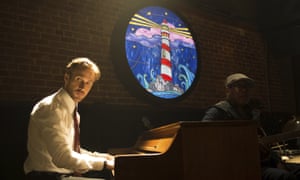It was a film I couldn’t wait to watch again, and when I did, the epiphany I should have had the first time presented itself. Is Ryan Gosling the new Debbie Reynolds? In Singin’ in the Rain, Reynolds plays Kathy, the would-be stage star who gets a bit hoity-toity with Gene Kelly about favouring legitimate theatre over his silly old movies: then she is hugely embarrassed, on jumping out of a cake at a Hollywood party as part of the entertainment, to see Kelly in the audience grinning cheekily at her.
Fast forward 60-odd years to 2017 and Ryan Gosling is Seb, in the comparably gorgeous musical romance La La Land, a struggling jazz musician who has just boorishly refused to accept congratulations on his performance from smart, pretty Mia, played by Emma Stone. Later, at a Hollywood poolside party, she is vastly amused to see super-serious Seb humiliatingly earning a buck as part of an 80s-style cover band, and mischievously calls out a request for A Flock of Seagulls’ I Ran, thus forcing Seb to play the lengthy synth break. Yet the humbling of Seb is more akin to Gene Kelly’s sudden aghast sense that he has gone too far in mocking Reynolds.
Writer-director Damien Chazelle’s allusion to Singin’ in the Rain is like the rest of his film: wonderfully judged, funny, romantic and charming. Chazelle plays out the seasons of Seb and Mia’s heartwrenching love affair, beginning and ending with winter, and incidentally engages in his own love affair with Los Angeles, where in some ways it seems always to be summer – except when it’s snowing in your heart. It’s a primary-coloured homage to classic movie musicals, an act of ancestor worship, splashing its poster-paint energy and dream-chasing optimism all over the screen.
La La Land seeks its own place somewhere on a continuum between Singin’ in the Rain and Woody Allen’s Everyone Says I Love You. There’s a tablespoon of Jacques Demy’s musicals, and something of the male-female dynamic in A Star Is Born. The director may also have been inspired by Alan Parker’s Fame for the opening sequence, in which a bunch of young kids with big dreams, symbolically stuck in a traffic jam on the freeway leading to Los Angeles, get out of their cars and stage a whopping dance number.
Gosling’s Seb is a lonely guy in LA, a conceited musical purist who has just spent his last penny trying and failing to open a jazz club in the city. He meets-cute with Stone’s Mia, stuck behind her car in this same traffic jam, while she looks through her pages for an audition she’s got later in the day. He pulls out to overtake with much male aggression; she gives him a glare. They are destined to meet again.
Stone has never been better: superbly smart, witty, vulnerable, her huge doe eyes radiating intelligence even, or especially, when they are filling with tears. Her audition scenes are 100% joy, especially the montage of her trying out for the part of cop, then ER doctor, then inspirational teacher: “No Jamal – you be tripping.” Stone is where the audience finds its emotional connection to the film; she mediates between them and Seb’s inner life, and with the daunting city of LA itself.
As for Gosling, he is excellent in his own way, an actor who has deepened a great deal since venturing into comedy. He is tough and sardonic, with a way of trying to conceal how hurt he is – or how in love he is. Like Stone, he is not a natural singer, yet there is something very real and human in the way they handle the songs. They are both very accomplished dancers in the shrewdly limited choreographed framework laid down for them.
Perhaps it shouldn’t rate a mention, but Seb and Mia aren’t shown having sex; there isn’t even a scene in which the camera tactfully absents itself from a steamy prelude. There is a kiss. And you see them living together. But, unlike any other kind of Hollywood movie, La La Land never needs to insist on its leads continuing to fancy each other. All its sensuality is projected upwards and outwards: into dance, into song, into the complex drama of their life choices pulling them apart.

There’s a moment when Seb and Mia are strolling through the Warner Brothers back lot when she points out the window from which Ingrid Bergman and Humphrey Bogart looked out on to Paris in Casablanca. It’s not too much of a stretch to put Stone and Gosling in that league, tough and tender respectively.
Since you’re here…
…we have a small favour to ask. More people are reading the Guardian than ever but far fewer are paying for it. And advertising revenues across the media are falling fast. So you can see why we need to ask for your help. The Guardian’s independent, investigative journalism takes a lot of time, money and hard work to produce. But we do it because we believe our perspective matters – because it might well be your perspective, too.
If everyone who reads our reporting, who likes it, helps to pay for it, our future would be much more secure.









